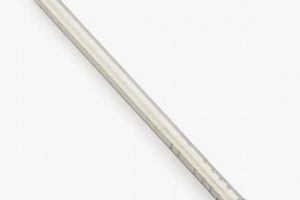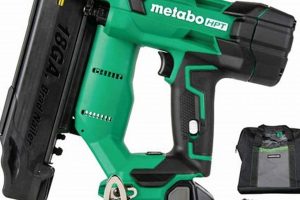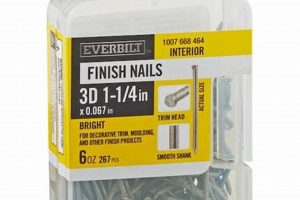These fasteners, produced by DeWalt, are designed for fine woodworking and trim applications. Characterized by their small head size, they are driven into materials to provide a secure hold with minimal visibility. An example use case includes attaching crown molding or installing door casings where a clean, unobtrusive finish is desired.
The significance of using such fasteners lies in their ability to create a professional, aesthetically pleasing result. They minimize the need for extensive filling and sanding, saving time and labor. Historically, advancements in fastener technology have led to stronger, more reliable nails suitable for a wider range of materials and power tools.
The following sections will delve into the specific features, suitable applications, selection considerations, and proper usage techniques concerning these types of fasteners, providing a comprehensive understanding for both novice and experienced users.
Tips for Optimal Use of DeWalt Finish Nails
This section outlines best practices for using these fasteners to achieve professional results and avoid common pitfalls.
Tip 1: Select the Appropriate Gauge and Length: The gauge and length must be chosen based on the material thickness and the intended application. Thinner materials require smaller gauge nails to prevent splitting, while thicker materials necessitate longer nails for adequate holding power. For example, when attaching thin trim to a door frame, use 18-gauge nails with a shorter length.
Tip 2: Utilize the Correct Nailer: Ensure that the pneumatic or cordless nailer is compatible with the specific gauge and length. Using an incompatible nailer can lead to misfires, jams, and damage to the workpiece or the tool itself. DeWalt offers a range of nailers designed for various finish nail sizes.
Tip 3: Adjust Nailer Depth Settings: Calibrate the depth setting on the nailer to ensure the nail head is flush with the surface without damaging the surrounding material. Test the setting on a scrap piece of the same material before commencing the actual project. An over-driven nail head will mar the finish, while an under-driven nail requires manual setting.
Tip 4: Maintain a Consistent Angle: Maintain a consistent angle when driving the nails. This ensures uniform penetration and prevents the nails from bending or breaking. Angled driving can also affect the aesthetic appeal of the finished project.
Tip 5: Consider Wood Grain Direction: Drive nails perpendicular to the wood grain whenever possible. This maximizes holding power and reduces the risk of splitting the wood. Driving nails along the grain can weaken the material.
Tip 6: Apply Adhesive When Necessary: For added strength, especially in high-stress applications or when working with materials that are prone to movement, use construction adhesive in conjunction with these fasteners. The adhesive provides a supplementary bond, enhancing the overall durability of the connection.
Tip 7: Inspect the Fasteners Regularly: Check for damaged or bent fasteners before loading them into the nailer. Using damaged fasteners can cause jams and potentially damage the tool.
Adhering to these guidelines ensures projects are completed efficiently and effectively, yielding durable and visually appealing results.
The concluding section will summarize key aspects of using these nails and offer final recommendations.
1. Gauge and Length
The selection of appropriate gauge and length is paramount when utilizing DeWalt finish nails. These specifications directly impact the fastener’s holding power, visibility, and the integrity of the materials being joined. Inadequate selection can lead to compromised structural integrity or aesthetic imperfections.
- Gauge and Material Splitting
Gauge refers to the diameter of the nail shaft. A higher gauge number indicates a thinner nail. When working with delicate materials or thin trim, using a larger gauge nail can result in splitting the wood. Conversely, a smaller gauge may not provide sufficient holding power for heavier materials. DeWalt offers a range of gauges to address various material densities and thicknesses.
- Length and Holding Power
The length of the nail determines the depth of penetration into the base material, thus affecting its holding power. Insufficient length results in a weak joint prone to failure under stress. As a general guideline, the nail should penetrate at least two-thirds of the thickness of the base material. However, excessively long nails can protrude through the back of the material or cause unsightly bulging. Selecting the proper length ensures a secure and clean finish.
- Gauge, Length, and Nailer Compatibility
DeWalt finish nailers are designed to accommodate specific gauge and length ranges. Attempting to use nails outside of the specified parameters can cause jams, misfires, and damage to the tool. Consulting the nailer’s manual and ensuring the nail specifications match the tool’s capabilities is crucial for safe and efficient operation.
- Aesthetic Considerations
The gauge and length also influence the final appearance of the finished project. Smaller gauge nails leave smaller holes that are easier to conceal with wood filler, resulting in a more refined look. The length should be appropriate to prevent the nail from protruding or bending, which detracts from the aesthetic appeal. Therefore, choosing the right gauge and length is essential for achieving both structural integrity and visual appeal when working with these nails.
Ultimately, the ideal gauge and length of DeWalt finish nails depend on a careful assessment of the material properties, the intended application, and the capabilities of the chosen nailer. Proper selection balances the need for sufficient holding power with the desire for a clean, professional finish, resulting in durable and aesthetically pleasing outcomes.
2. Nailer Compatibility
The proper functioning of any DeWalt finish nail depends critically on nailer compatibility. The selection of a DeWalt finish nail, irrespective of its gauge, length, or head type, must align directly with the specifications of the finish nailer being used. An incompatible nail can cause tool malfunctions, project damage, and potential safety hazards. For example, using an 18-gauge nail in a 15-gauge nailer will invariably lead to misfires and potential damage to the nailer’s internal mechanisms. Conversely, attempting to load a collated strip of incorrect length may jam the feed mechanism, rendering the nailer inoperable. Proper understanding of these cause-and-effect relationships is essential to maintain operational efficiency and extend tool life.
Nailer compatibility extends beyond mere gauge and length. The collation type, whether strip or coil, and the angle of collation, also dictate compatibility. Some nailers are designed to accept only specific collation types, while others offer greater versatility. DeWalt nailers, for instance, often specify the precise collation angle required for proper feeding and firing. Further, the fastener material, such as galvanized steel or stainless steel, should be considered in conjunction with the tool’s intended use and environmental factors. Using incompatible fastener materials can accelerate tool wear or compromise the integrity of the finished product. A failure to consider these factors can result in suboptimal performance, increased downtime, and potentially unsafe working conditions.
Therefore, verification of nailer compatibility with DeWalt finish nails is a non-negotiable step in any finishing project. The user should meticulously consult the nailer’s operator manual for precise specifications regarding acceptable nail types, gauges, lengths, and collation. The consequences of ignoring these guidelines can range from minor inconveniences to significant safety risks. Proper attention to this aspect ensures both the longevity of the nailer and the quality of the finished work.
3. Material Suitability
The effectiveness of DeWalt finish nails is intrinsically linked to the material into which they are driven. Material suitability encompasses factors such as wood density, grain direction, presence of knots, and moisture content. Failure to account for these variables can result in compromised holding power, splitting, or aesthetic imperfections. For instance, driving a long, thick-gauge nail into brittle MDF (Medium-Density Fiberboard) will likely cause the material to fracture and crumble. Conversely, a short, thin nail may provide insufficient grip in dense hardwoods such as oak or maple, leading to a weak and unstable joint. Similarly, nailing into wood with a high moisture content can lead to corrosion and subsequent loosening of the fastener as the wood dries and shrinks. Understanding material properties is, therefore, a prerequisite for successful and durable finishing work.
Practical applications highlight the importance of material suitability. In cabinet making, for example, where aesthetics and structural integrity are paramount, careful consideration must be given to the type of wood being used and the appropriate nail selection. Softer woods, like pine, require finer gauge nails to prevent splitting, while harder woods may necessitate pre-drilling pilot holes to ease nail insertion and prevent bending. When attaching trim to drywall, specialized nails designed for this purpose are crucial to ensure a secure and flush attachment. Similarly, in outdoor applications, using stainless steel finish nails is essential to prevent corrosion and maintain joint integrity in the face of moisture and environmental exposure. These examples illustrate how the success of any project involving these fasteners hinges on a thorough understanding of material-specific requirements.
In conclusion, selecting the correct DeWalt finish nails demands a nuanced understanding of material properties and the intended application. The consequences of neglecting material suitability can range from cosmetic flaws to structural failures. By carefully assessing factors such as wood density, moisture content, and environmental conditions, users can ensure optimal performance and longevity of their finished projects. A proactive approach to material assessment minimizes risks, maximizes efficiency, and ultimately yields a superior finished product.
4. Corrosion Resistance
Corrosion resistance is a critical attribute governing the longevity and performance of DeWalt finish nails, particularly in environments prone to moisture, humidity, or chemical exposure. The selection of corrosion-resistant finish nails is essential to prevent degradation, maintain structural integrity, and preserve the aesthetic appearance of finished projects. The following points detail key facets of corrosion resistance relevant to these fasteners.
- Galvanization Processes
Galvanization, involving the application of a zinc coating, provides a sacrificial barrier against corrosion. When the zinc coating is scratched or damaged, it corrodes preferentially, protecting the underlying steel. DeWalt finish nails often utilize galvanization for indoor applications or environments with moderate humidity. Electrogalvanization offers a thinner, smoother coating, while hot-dip galvanization provides a thicker, more robust protection layer, suitable for more demanding environments. The choice of galvanization process directly affects the nail’s resistance to rust and its overall lifespan.
- Stainless Steel Composition
Stainless steel finish nails offer superior corrosion resistance due to their inherent chromium content, which forms a passive protective layer on the surface. This layer self-repairs when scratched, preventing rust propagation. Stainless steel is recommended for outdoor applications, coastal environments, and projects involving contact with treated lumber or corrosive chemicals. Different grades of stainless steel, such as 304 and 316, provide varying levels of corrosion resistance, with 316 offering enhanced protection against chloride exposure common in marine environments.
- Environmental Considerations
The anticipated environmental conditions should dictate the choice of corrosion-resistant DeWalt finish nails. High humidity, saltwater exposure, and contact with acidic or alkaline substances accelerate corrosion processes. In such settings, stainless steel or specialized coated nails are crucial to prevent premature failure. Conversely, for dry indoor environments, galvanized nails may suffice. Understanding the specific corrosive agents present in the application environment is essential for selecting the appropriate level of protection.
- Impact on Project Longevity
The selection of corrosion-resistant DeWalt finish nails directly impacts the long-term durability and aesthetic appeal of finished projects. Using non-resistant or inadequately protected nails in corrosive environments can lead to rust staining, joint weakening, and costly repairs or replacements. Prioritizing corrosion resistance ensures that the finished product maintains its structural integrity and visual appeal over time, minimizing maintenance requirements and maximizing the return on investment. The small incremental cost associated with corrosion-resistant fasteners is offset by the substantial savings in future repairs and replacements.
These facets of corrosion resistance highlight the necessity of careful material selection when using DeWalt finish nails. By considering the environmental conditions, material compatibility, and desired project lifespan, users can effectively mitigate the risks associated with corrosion and ensure the enduring quality of their finished work.
5. Head Style/Type
The head style of a DeWalt finish nail directly influences its performance, aesthetic impact, and suitability for specific applications. The correct head style ensures proper setting, secure fastening, and minimal visibility in the finished product. Choosing the appropriate head style is as crucial as selecting the correct gauge, length, and material.
- Brad Heads
Brad heads are characterized by their minimal size, designed to be nearly invisible upon installation. These heads are ideal for delicate trim work and fine woodworking where aesthetics are paramount. Due to their small surface area, brad heads offer less holding power compared to other head types. DeWalt finish nails with brad heads are commonly used for attaching small moldings, picture frames, and cabinet backs where minimal visual disruption is desired and heavy-duty fastening is not required. Proper setting, often flush or slightly recessed, is essential to maximize their aesthetic advantage and prevent interference with subsequent finishing processes.
- Angled Finish Heads
Angled finish heads, also known as DA heads, feature an offset design that allows for tighter nail placement in corners and hard-to-reach areas. This head type is commonly used in applications such as installing crown molding, baseboards, and door casings. The angled design provides increased holding power compared to brad heads, while still maintaining a relatively low profile. DeWalt finish nails with angled heads are designed for use in compatible angled finish nailers, ensuring proper feeding and setting. The angle facilitates consistent nail placement, minimizing the risk of splitting the wood and providing a clean, professional finish.
- Straight Finish Heads
Straight finish heads offer a balance between holding power and aesthetic appeal. These heads are slightly larger than brad heads but smaller than standard nail heads, providing a secure hold while remaining relatively unobtrusive. Straight finish head nails are versatile and suitable for a wide range of applications, including attaching trim, baseboards, and paneling. DeWalt finish nails with straight heads are designed for use in straight finish nailers, ensuring consistent driving depth and preventing damage to the surrounding material. Their larger surface area provides increased resistance to pull-through, making them suitable for projects requiring a more robust fastening solution.
- Headless Pins
Headless pins represent the most minimal option in terms of visibility. They have virtually no head, allowing for near-invisible fastening. They are primarily used for temporary holding or in applications where the aesthetic requirements are exceptionally high and the load-bearing requirements are low. DeWalt headless pins are often used to hold pieces together while glue dries or to secure delicate materials that cannot withstand larger fasteners. Given their minimal holding power, headless pins are typically used in conjunction with adhesives for permanent bonding. The near-absence of a head allows for easy concealment with wood filler or paint, resulting in a seamless finish.
The selection of the appropriate head style for DeWalt finish nails requires careful consideration of the project’s specific requirements. From the nearly invisible brad heads to the more robust straight finish heads, each type offers a unique balance of holding power and aesthetic appeal. By understanding the characteristics and applications of each head style, users can ensure that their projects not only meet structural requirements but also achieve a professional and visually appealing finish.
Frequently Asked Questions
This section addresses common queries regarding the selection, application, and performance characteristics of these fasteners, providing definitive answers based on established industry practices and product specifications.
Question 1: What factors determine the correct length?
Optimal length is dictated by the combined thickness of the materials being joined. A general rule suggests the nail should penetrate the base material by at least two-thirds of its thickness. Overly long nails may protrude, while insufficient length compromises holding power.
Question 2: Can these fasteners be used in treated lumber?
The use of standard galvanized finish nails in treated lumber is discouraged due to the corrosive nature of the chemicals used in wood treatment. Stainless steel fasteners are recommended for such applications to prevent premature corrosion and structural failure.
Question 3: What gauge is appropriate for attaching thin trim?
An 18-gauge finish nail is generally suitable for attaching thin trim, as its smaller diameter minimizes the risk of splitting the wood. Heavier trim may require a 16 or 15-gauge nail for increased holding power.
Question 4: How can nail gun jams be prevented?
Regularly cleaning and maintaining the nail gun according to the manufacturer’s instructions is crucial. Ensuring the fasteners are properly collated and free of debris also helps to prevent jams. Use only DeWalt finish nails specifically designed for the nailer model being employed.
Question 5: Is pre-drilling necessary when using these fasteners?
Pre-drilling is generally not required for softer woods. However, when working with hardwoods or when nailing close to the edge of the material, pre-drilling can prevent splitting and ensure accurate nail placement.
Question 6: Are these fasteners suitable for outdoor use?
The suitability of these fasteners for outdoor use depends on their material composition. Galvanized finish nails may offer limited protection in dry outdoor environments, but stainless steel fasteners are recommended for prolonged exposure to moisture and harsh weather conditions.
Proper understanding and adherence to these guidelines ensure optimal performance and longevity when utilizing DeWalt finish nails.
The concluding section will summarize essential considerations and offer final recommendations.
DeWalt Finish Nails
The preceding analysis has explored various facets of DeWalt finish nails, underscoring the critical importance of proper selection and application. Gauge and length, nailer compatibility, material suitability, corrosion resistance, and head style significantly impact the fastener’s performance and the overall quality of the finished project. Ignoring these factors can lead to compromised structural integrity, aesthetic flaws, and premature failure.
Therefore, a comprehensive understanding of DeWalt finish nails and their intended use is essential for achieving durable and visually appealing results. Diligent planning, careful material selection, and adherence to established best practices are necessary to ensure the longevity and effectiveness of any project utilizing these fasteners. Failure to prioritize these considerations introduces unnecessary risk and undermines the value of the completed work.







